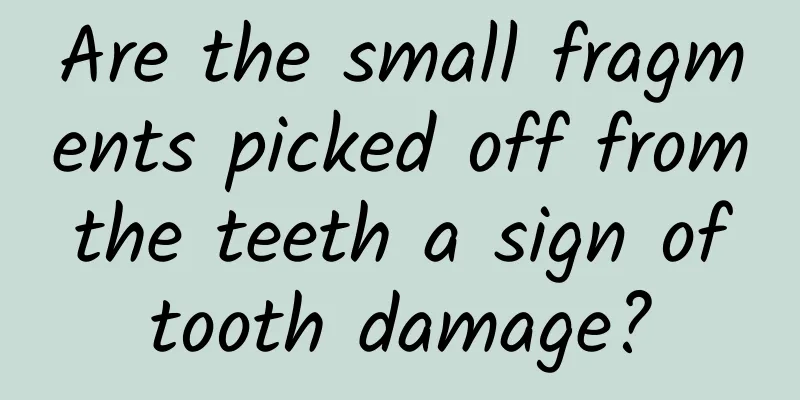Are the small fragments picked off from the teeth a sign of tooth damage?

|
gossip “Sometimes you can pick off small pieces of debris from your teeth, which means your teeth are damaged!” If we use our fingernails to scratch the inside of the teeth, some hard small fragments will fall off. Some people say that these are tooth fragments, which means that the teeth are damaged. Rumor Analysis This statement is not rigorous. In most cases, these small pieces are actually dental plaque, not the teeth themselves. However, if you often have such fragments in your mouth, you really need to pay attention to your oral health. If you ask, what is the dirtiest part of the human body? Most people may first think of the human excretion channel: the anus. But the truth may surprise many people - the "dirtiest" part is not where food goes out, but where it comes from: the mouth. According to statistics, there are hundreds of billions of bacteria in the mouth, and they move back and forth every time people breathe, eat, and secrete saliva. And their impact is huge. The "Fourth National Oral Health Epidemiological Survey Report" shows that the periodontal health rate among adults in China is only 9.1%, which means that at least 1 billion people have periodontal problems of varying degrees. Copyrighted stock images, no reproduction is authorized If you are also facing problems such as swollen gums, loose teeth, bad breath, etc., this article is for you. Dental tartar is more common than you think One of the main factors affecting periodontal health and even oral health is dental tartar. Many people may have had this experience: after drinking a carbonated beverage or accidentally biting something hard, some white porcelain pieces with a faint smell will fall off their teeth. Some people think that this is a broken tooth that needs to be filled. But in fact, in most cases, they are not tooth fragments, but calculus attached to the teeth. Unlike calculus in other parts of the body, the formation of dental calculus is extremely simple: if you don't clean it carefully, the residue left in the corners of your mouth after eating and the residue left by brushing your teeth will cause dental plaque to grow rapidly. After mineralization is completed, dental calculus will appear in two days. Compared with the ease of formation, it is very difficult to clean dental calculus. After forming, dental plaque is difficult to fall off on a large scale by itself, and will only continue to grow like a pile of sand. Not only can it firmly adhere to the surface of the teeth along the gums, but it can also hide in the narrow grooves between the teeth and gums. It is difficult to remove it by ordinary brushing or flossing. The most important thing is that they are very good at camouflage. The surface of these dental calculus is mostly yellow-white, which is close to the color of teeth. If you don’t pay attention, you may even think they are part of the teeth. No wonder some friends think that the small pieces they pick off are teeth. Seeing this, some people may speculate: Is it so serious? In fact, you may just not have noticed it. According to the results of the fourth national oral health epidemiological survey, the detection rate of dental calculus in people aged 35 to 44 is as high as 96.7%. Not only adults, but also children. The detection rate of dental calculus in people aged 3 to 5 is also as high as 73.6%. These oral "parasites" that accompany many people from childhood to adulthood are actually the source of many oral problems. These oral problems are caused by dental calculus. 1 Causes tooth decay The density of cells in dental calculus is extremely high, about 200 million per milligram, and these cells are mainly bacteria. The bacteria on the surface of dental calculus secrete acidic substances, corroding teeth, forming "wormholes" one by one, causing tooth decay, also known as caries. It is worth noting that if these cavities are not treated, they are difficult to heal on their own. Instead, they will expand little by little and continue to penetrate deeper into the tooth, eventually leading to the destruction of the crown and subsequent tooth loss. The saying "If you don't fix a small hole, you will suffer from a big hole" is absolutely true. 2 Causes bad breath Everyone has probably seen a “magic cure for bad breath” on social media, but in reality, it’s difficult to get rid of bad breath if you don’t understand the source of it. As we mentioned above, the original source of dental plaque is various food residues and bacteria, which parasitize on the teeth and slowly ferment in the mouth to produce sulfide. This is one of the main sources of bad smell. Copyrighted stock images, no reproduction is authorized 3 Disturbance to appearance There is a popular saying that teeth can be stained by dark drinks such as coffee. In fact, most of our teeth are beige in color, and it is dental plaque that is easily stained. They easily absorb exogenous pigments, making teeth look dark and yellow. Whether they are old smokers who don't pay attention to oral hygiene, or sophisticated people who can't put down coffee or red wine, once they are affected by dental plaque, they will face the same troubles. 4 Causes periodontitis and tooth loss After tartar attaches to the teeth, it will continue to recruit bacteria and start from the gums, constantly eroding inward all the way to the periodontal membrane, alveolar bone and cementum, eventually developing into periodontitis, which is not only prone to bad breath and bleeding gums, but in severe cases it can also cause tooth loss. In the early stages, they often have no obvious symptoms. By the time it is discovered that the gums are separated from the tooth roots and the teeth are loose, it is actually already very serious. How to fight dental plaque Tartar is so easy to form, and its harmful effects are so widespread, is there no way to deal with it? The good news is that although it is not easy for us to deal with tartar by ourselves, it is much easier for professional dentists to fight tartar with handheld dental equipment. The most effective method is teeth cleaning. Copyrighted stock images, no reproduction is authorized The teeth cleaning here does not mean literal meaning, but requires going to a regular hospital, the periodontology department, or the general dentistry department, and having the doctor use professional equipment to remove tartar. Some people worry that the gaps between teeth will be widened after teeth cleaning. In fact, this is a complete misunderstanding. Teeth cleaning does not use a high-pressure water gun to wash away dirt, but mostly uses ultrasonic teeth cleaning: through high-frequency vibration, oral dirt including dental calculus is removed. As for those buried deep under the gums, a scaler is also used. It seems that the gaps between your teeth widen after teeth cleaning, only because the tartar that was originally squeezed in the gaps between your teeth has been removed. In other words, due to the presence of tartar, your gaps between your teeth are already that big, and if you don't clean your teeth in time, they will get bigger and bigger. A teeth cleaning lasts no more than an hour, but it can remove most of the tartar and reduce the possibility of oral diseases. After teeth cleaning, the doctor will often polish the teeth to restore the original gloss of the teeth and reduce the absorption of tartar. The "Guidelines for Oral Health of Chinese Residents" recommends that teeth be cleaned at least once a year. The most important thing is that in the hospital, doctors often do not just clean your teeth, but often conduct a comprehensive examination of the oral cavity to determine whether the formation of tartar is interfered with by other factors, such as periodontitis caused by diabetes. In addition, the doctor will determine whether there are other less noticeable but equally serious problems besides dental tartar. When it comes to oral health, prevention is also important In fact, most oral problems are related to the way we clean our teeth. The "Fourth National Oral Health Epidemiological Survey" shows that only 36.1% of adults in my country brush their teeth twice a day. It is very necessary to brush your teeth once in the morning and once in the evening because there is usually a ten-hour interval between them. During this period, bacteria will continue to multiply and food debris will continue to accumulate, increasing the risk of tartar formation. In addition to the number, the method and time are also important. Here are a few points to note for your reference. 1 Brush your teeth with the toothbrush upright, and the brushing time should be more than three minutes. Brushing your teeth sideways cannot really remove dirt, and it can also cause defects at the neck of the teeth, resulting in tooth sensitivity and pain. Moreover, adults often have more than 28 teeth. If you want to brush every tooth and every side, you must ensure the brushing time. Choose a toothbrush with a small brush head and soft bristles, and replace it every three months. Our oral cavity is often very small, and a large brush head can only clean the surface, while hard bristles will damage the tooth enamel. At the same time, once a toothbrush is used for a long time, it will also be contaminated with bacteria, so it is best to replace it regularly. Use dental floss and water flosser regularly, and have your teeth cleaned at least once a year Brushing your teeth can only remove most of the residue, but it is still difficult for the toothbrush head to clean the bacteria in the fine details. Dental floss and water flossers that can reach the details can clean more thoroughly. But they cannot eradicate dental plaque, so it is best to follow the advice and have your teeth cleaned once a year in the hospital. To protect your teeth, start by brushing your teeth well and cleaning them regularly. References [1]Jepsen S, Deschner J, Braun A, Schwarz F, Eberhard J (2011). "Calculus removal and the prevention of its formation". Periodontology 2000. 55 (1): 167–88. [2]White DJ (1997). "Dental calculus: recent insights into occurrence, formation, prevention, removal and oral health effects of supragingival and subgingival deposits". European Journal of Oral Sciences. 105 (5 Pt 2): 508–22. [3]White DJ (1991). "Processes contributing to the formation of dental calculus". Biofouling. 4 (1–3): 209–218. [4]Socransky SS, Haffajee AD (2002). "Dental biofilms: difficult therapeutic targets". Periodontology 2000. 28 (1): 12–55. [5]Socransky SS, Haffajee AD (2005). "Periodontal microbial ecology". Periodontology 2000. 38 (1): 135–87. [6] Feng Xiping. Oral health status of Chinese residents: Report on the fourth epidemiological survey on oral health in China [C]. Oral Preventive Medicine Committee of the Chinese Stomatological Association. Author: Li Mi Popular Science Author Reviewer: Tang Qin, Director and Researcher of the Science Popularization Department of the Chinese Medical Association |
<<: This generation of young people rely on "sound massage" to help them sleep
>>: World Water Day: A review of the “water artifacts” invented in ancient China
Recommend
2019 Alipay product operation analysis!
1. Product Overview 1.1 Product Introduction Prod...
NetEase Yanxuan product analysis
This year's Double 11 is in full swing. Liang...
In 2022, both liberal arts and science majors will have to escape from the palm of their hands | New Year's Day Special
Although the New Year is just a time scale artifi...
How to modify SEO when a new website is launched? How to perform SEO optimization?
Due to inadequate early planning of location cons...
Case Analysis: How to impact the Weibo topic list with 0 budget and link up 30 apps?
If you are working on new media in an APP, then c...
What time does the opening ceremony of the 2022 CPPCC National Committee begin? Attached is the time and live broadcast address of the CPPCC’s first press conference!
As the 2022 National People’s Congress and the Ch...
Fanstong operation experience—original and practical information! (Analyze usage scenarios, increase user density, and be creative)
During the operation process, great emphasis is p...
More than 100,000 followers in 4 days, let’s talk about user fission growth!
One year and several months of practical experien...
How to increase followers and monetize by creating short videos!
1141.3W, on Kuaishou, this fan base exceeds that ...
These 20 "health care" suggestions are all wrong, don't be misled anymore!
“Drinking more porridge can nourish the stomach”,...
4 steps to complete Baidu information flow delivery! Home decoration case sharing~
The home improvement industry is a typical large ...
"The fourth shot" vaccine, can I still get it if I have a positive test result? What should I pay attention to when getting vaccinated? Expert interpretation →
On December 14, the National Health Commission re...
Baidu bidding promotion planning, what should we pay attention to in the system of Baidu bidding promotion plan?
A high-quality bidding promotion plan is the begi...
The Great Voyage丨Were Tang Dynasty wooden sailing ships so advanced?
Rugao Tang Dynasty Wooden Sailing Ship In the &qu...
Maximizing IP value from the acquisition of the copyright of the popular comic "Dragon Sakura" by Alibaba
There have been rumors of Alibaba's involveme...









